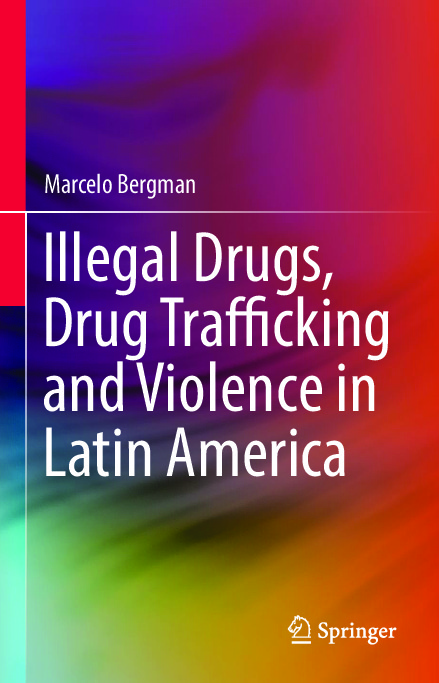File #2436: "2018_Book_IllegalDrugsDrugTraffickingAnd.pdf"
Text
1|Preface and Acknowledgments|5
1|Contents|7
1|Chapter 1: Introduction|10
2|1.1 Brief Summary|12
3|1.1.1 Drugs and Illegality|12
3|1.1.2 Prevalence and Production|12
3|1.1.3 The Effects of the Drug Trade|13
3|1.1.4 Drug Trafficking, Violence, and Criminal Justice|14
3|1.1.5 The Fight Against Drug Trafficking|15
3|1.1.6 Policy Alternatives|16
3|1.1.7 Open-Ended Questions|16
2|1.2 Book Chapters|17
1|Part I: The Business of Drugs and the Political Economy of Narcotics|19
2|Chapter 2: Illegal Markets and the Demand for Illegal Substances|20
3|2.1 Theoretical Toolkit|21
3|2.2 Inelastic Demand and Control of Supply|22
3|2.3 The Segmentation of Drug Use|23
3|2.4 The Craving for Drugs|25
3|2.5 Prohibition: Winners and Losers|26
3|2.6 Illegal Markets and Violence|27
3|2.7 Prohibition and Public Opinion|28
3|2.8 Control Strategies|31
3|References|32
2|Chapter 3: The Use of Illegal Drugs in Latin America: A Brief Introduction|34
3|3.1 Illegal Drugs|35
3|3.2 Cost Structure and Profits|37
4|3.2.1 Production and Sales of Illegal Drugs: Several Important Considerations|38
4|3.2.2 Price Structure|39
3|3.3 The Scope of Drug Use in the Region|42
3|References|47
2|Chapter 4: The Business Structure of Illegal Drugs: Concentration-Fragmentation, Cartels, and Extreme Violence|49
3|4.1 Cartels and the Basic Business Structure|49
3|4.2 Violence|56
3|4.3 Concluding Remarks|64
3|References|64
1|Part II: The Threat of Illegal Drugs and Criminal Justice Systems Response|66
2|Chapter 5: Criminal Diversification and Corruption in the Drug Business|67
3|5.1 Extortion|68
3|5.2 State Weakness and Corruption|72
3|5.3 North and South|74
3|5.4 In Conclusion|75
3|References|76
2|Chapter 6: Drugs, Trafficking, and Criminal Justice|77
3|6.1 Institutional Structure and Drug Trafficking|78
3|6.2 What Do States Do to Combat Trafficking?|79
3|6.3 Implications|85
3|6.4 By Way of Conclusion|87
3|References|88
1|Part III: Policy Options|89
2|Chapter 7: What Can Be Done About Drugs? Public Policy Options|90
3|7.1 Drug Types and Policy Strategies|91
3|7.2 Emerging vs. Consolidated Markets|92
3|7.3 Recreational Use and Addiction|93
3|7.4 Initiation, Spread and Diversification in the Use of Different Substances|95
3|7.5 Availability and Use|96
3|7.6 Cannabis|97
3|7.7 Summary|99
3|References|100
2|Chapter 8: Legalize, Regulate, or Prohibit? Public Policy Dilemmas|102
3|8.1 Policy Options|103
4|8.1.1 Prohibition|103
5|8.1.1.1 Drug Crop Eradication|104
5|8.1.1.2 Trafficking|105
5|8.1.1.3 Sales|106
4|8.1.2 Legalization|106
4|8.1.3 Regulation|108
3|8.2 Prevention and Treatment|110
3|8.3 Public Health and Damage Reduction|112
3|8.4 In Conclusion|114
3|References|114
1|Part IV: Case Studies|115
2|Chapter 9: Notes on Illegal Drugs and Trafficking in Argentina|116
3|9.1 Legal Framework|117
3|9.2 Argentina: Transit or Destination Country?|118
4|9.2.1 Transit|119
4|9.2.2 Argentina’s Domestic Market|122
4|9.2.3 Summary|127
3|9.3 What Is the Social Cost of Drugs?|127
3|9.4 What Is the Scope of the Domestic Market for Illegal Substances?|128
4|9.4.1 Cocaine|129
4|9.4.2 Marijuana|131
4|9.4.3 Summary|133
3|9.5 Where the Domestic Drug Market Is Heading in Argentina?|133
3|9.6 Will Argentina Become Another Mexico? Or Another Colombia?|134
3|9.7 Reflections on Argentina|136
3|References|137
2|Chapter 10: Mexico|139
3|10.1 Mexico’s War on Drugs: An Overview|140
4|10.1.1 The Human Toll|140
4|10.1.2 Beyond the Human Toll|142
3|10.2 Domestic Market|143
4|10.2.1 Prevalence|143
4|10.2.2 Market Size|147
4|10.2.3 Market Value|149
3|10.3 Drug Wars and Violence in Mexico|152
3|References|154
1|Bibliography|156
1|Index|157
1|Contents|7
1|Chapter 1: Introduction|10
2|1.1 Brief Summary|12
3|1.1.1 Drugs and Illegality|12
3|1.1.2 Prevalence and Production|12
3|1.1.3 The Effects of the Drug Trade|13
3|1.1.4 Drug Trafficking, Violence, and Criminal Justice|14
3|1.1.5 The Fight Against Drug Trafficking|15
3|1.1.6 Policy Alternatives|16
3|1.1.7 Open-Ended Questions|16
2|1.2 Book Chapters|17
1|Part I: The Business of Drugs and the Political Economy of Narcotics|19
2|Chapter 2: Illegal Markets and the Demand for Illegal Substances|20
3|2.1 Theoretical Toolkit|21
3|2.2 Inelastic Demand and Control of Supply|22
3|2.3 The Segmentation of Drug Use|23
3|2.4 The Craving for Drugs|25
3|2.5 Prohibition: Winners and Losers|26
3|2.6 Illegal Markets and Violence|27
3|2.7 Prohibition and Public Opinion|28
3|2.8 Control Strategies|31
3|References|32
2|Chapter 3: The Use of Illegal Drugs in Latin America: A Brief Introduction|34
3|3.1 Illegal Drugs|35
3|3.2 Cost Structure and Profits|37
4|3.2.1 Production and Sales of Illegal Drugs: Several Important Considerations|38
4|3.2.2 Price Structure|39
3|3.3 The Scope of Drug Use in the Region|42
3|References|47
2|Chapter 4: The Business Structure of Illegal Drugs: Concentration-Fragmentation, Cartels, and Extreme Violence|49
3|4.1 Cartels and the Basic Business Structure|49
3|4.2 Violence|56
3|4.3 Concluding Remarks|64
3|References|64
1|Part II: The Threat of Illegal Drugs and Criminal Justice Systems Response|66
2|Chapter 5: Criminal Diversification and Corruption in the Drug Business|67
3|5.1 Extortion|68
3|5.2 State Weakness and Corruption|72
3|5.3 North and South|74
3|5.4 In Conclusion|75
3|References|76
2|Chapter 6: Drugs, Trafficking, and Criminal Justice|77
3|6.1 Institutional Structure and Drug Trafficking|78
3|6.2 What Do States Do to Combat Trafficking?|79
3|6.3 Implications|85
3|6.4 By Way of Conclusion|87
3|References|88
1|Part III: Policy Options|89
2|Chapter 7: What Can Be Done About Drugs? Public Policy Options|90
3|7.1 Drug Types and Policy Strategies|91
3|7.2 Emerging vs. Consolidated Markets|92
3|7.3 Recreational Use and Addiction|93
3|7.4 Initiation, Spread and Diversification in the Use of Different Substances|95
3|7.5 Availability and Use|96
3|7.6 Cannabis|97
3|7.7 Summary|99
3|References|100
2|Chapter 8: Legalize, Regulate, or Prohibit? Public Policy Dilemmas|102
3|8.1 Policy Options|103
4|8.1.1 Prohibition|103
5|8.1.1.1 Drug Crop Eradication|104
5|8.1.1.2 Trafficking|105
5|8.1.1.3 Sales|106
4|8.1.2 Legalization|106
4|8.1.3 Regulation|108
3|8.2 Prevention and Treatment|110
3|8.3 Public Health and Damage Reduction|112
3|8.4 In Conclusion|114
3|References|114
1|Part IV: Case Studies|115
2|Chapter 9: Notes on Illegal Drugs and Trafficking in Argentina|116
3|9.1 Legal Framework|117
3|9.2 Argentina: Transit or Destination Country?|118
4|9.2.1 Transit|119
4|9.2.2 Argentina’s Domestic Market|122
4|9.2.3 Summary|127
3|9.3 What Is the Social Cost of Drugs?|127
3|9.4 What Is the Scope of the Domestic Market for Illegal Substances?|128
4|9.4.1 Cocaine|129
4|9.4.2 Marijuana|131
4|9.4.3 Summary|133
3|9.5 Where the Domestic Drug Market Is Heading in Argentina?|133
3|9.6 Will Argentina Become Another Mexico? Or Another Colombia?|134
3|9.7 Reflections on Argentina|136
3|References|137
2|Chapter 10: Mexico|139
3|10.1 Mexico’s War on Drugs: An Overview|140
4|10.1.1 The Human Toll|140
4|10.1.2 Beyond the Human Toll|142
3|10.2 Domestic Market|143
4|10.2.1 Prevalence|143
4|10.2.2 Market Size|147
4|10.2.3 Market Value|149
3|10.3 Drug Wars and Violence in Mexico|152
3|References|154
1|Bibliography|156
1|Index|157

